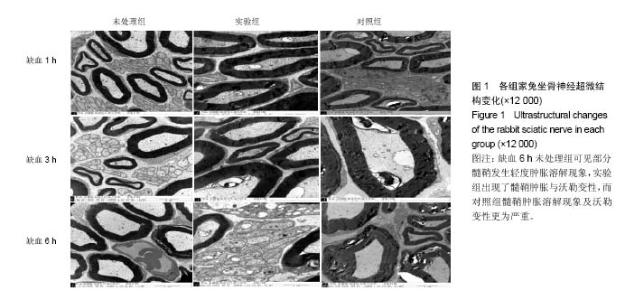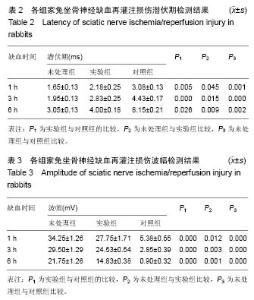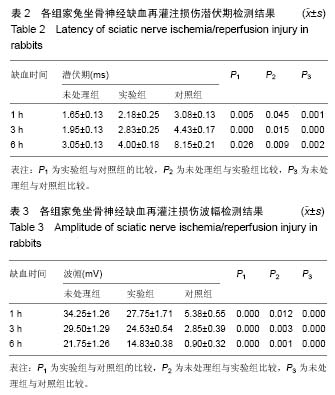| [1] 王琛,陈允震.周围神经损伤治疗研究进展[J].山东医药,2001, 41(7):57-58.[2] 李玲,梅晓云,陈文垲.补阳还五汤对夹伤神经再生的影响[J].中医研究,2007,20(12): 9-10[3] 徐北辰.周围神经损伤的药物治疗现状和进展[J].辽宁医学, 2014,35(4):99-101.[4] 王法,黄耀添,殷琦.周围神经缺血再灌注损伤的实验研究[J]. 中华骨科杂志,1996,16(11):723-725.[5] 黄敏,郭丽英,张静,等. α-硫辛酸与高压氧联合治疗糖尿病足疗效观察[J]. 河北医药,2014,36(19):2908-2911.[6] Mitsui Y, Schmelzer JD, Zollman PJ,et al. Hypothermic neuroprotection of peripheral nerve of rats from ischemia- reperfusion injury: intraischemic vs. reperfusion hypothermia. Brain Res. 1999,827(1-2):63-69.[7] 罗晓中,安洪.低温预防周围神经缺血再灌注损伤的形态学研究[J]. 中华手外科杂志,1999,15(1):59-60.[8] 师继红,黄耀添,徐新智. 手术治疗周围神经缺血再灌注损伤的电生理研究[J]. 中华显微外科杂志. 1997,20(2):116-119.[9] 肖海军,阙世廉.周围神经缺血再灌注损伤研究进展[J].医学综述, 2002,8(5):293-295.[10] 汤春芳,刘云国,徐卫华,等.硫辛酸的研究概况[J].中国生化药物杂志,2005,26(1):52-55.[11] 彭淼,雷宇.α-硫辛酸对缺血再灌注脑组织神经功能保护效应的实验研究[J]. 海南医学院学报,2016,22(12):1188-1191.[12] Kojima M, Sun L, Hata I, et al. Efficacy of alpha-lipoic acid against diabetic cataract in rat. Jpn J Ophthalmol. 2007; 51(1):10-13.[13] 李文俊. 穴位注射联合硫辛酸对糖尿病周围神经病变患者主觉症状及MDA、SOD、hs-CRP的影响[J].西南军医. 2015,17(2): 159-161.[14] 章晓燕,刘芳,贾伟平.硫辛酸与糖尿病周围神经病变[J]. 国外医学内分泌学分册. 2005,25(4):262-268.[15] 王焕从,赵军强. 当归四逆汤加减联合α-硫辛酸治疗糖尿病周围神经病变疗效观察[J]. 现代中西医结合杂志,2015,24(23): 2575-2577.[16] 孙荔,张劲松.硫辛酸对大鼠糖尿病白内障抑制作用的研究[J]. 中华眼科杂志,2004,40(3):193-196.[17] 王艳艳,施用晖,尹彩娜,等.硫辛酸对高脂日粮小鼠消化系统自由基清除作用研究[J].营养学报,2008,30(6):592-596.[18] 陈洁华,肖文娟,邹燕芳,等.硫辛酸治疗2型糖尿病周围神经病变对视诱发电位影响的临床研究[J].辽宁医学杂志,2015,29(1): 4-6.[19] Mccord JM. Oxygen-derived free radicals in postischemic tissues injury. New Eng J Med.1985;312(2):159-163.[20] 闫峰,赵咏梅,罗玉敏,等.大鼠局灶性脑缺血再灌注脑组织中活性氧自由基表达的时程变化[J]. 首都医科大学学报,2015,36(5): 694-698.[21] 许海江,孙同文,赵春玲. 丹参酮ⅡA对脑缺血再灌注损伤大鼠脑的保护作用[J]. 中国医院药学杂志. 2013, 33(16):37-47. [22] Wanderer AA.Proposed pathobiologic mechanisms of hypoxia-ischemia- reperfusion in corticosteroid-resistant neutrophilic asthma and consideration of interleukin 1 targeted therapy. Ann Allergy Asthma Immunol.2011;106(1): 69-72.[23] Schmidt CA, Rancie Z, Lachat ML, et al.Hypothermic, initially oxygen-free, controlled limb reperfusion for acute limb ischemia. Ann Vasc Surg. 2015;29(3):560-572.[24] 李俊平,郭丽丽,陈中,等. 钙超载与心肌缺血再灌注损伤及中药干预策略[J].中国中药杂志,2016,41(11):2168-2173.[25] Dyck PJ,Conn DZ,Okazaki H.Necrotizing angiopathic neuropathy: three-dimensional morphology of fiber degeneration related to site of occluded vessels. Mayo Clin Proc.1972;47(3):461-475.[26] Saray A,Can B,Akbiyik F,et al. Ischaemia-reperfusion injury of the peripheral nerve: An experimental study. Microsurgery. 1999;19(8): 374-380.[27] 黄涛,黄开勋. α-硫辛酸的生物医学功能[J].生命的化学, 2004, 24(1):58-60.[28] Stevens MJ,Obrosova I,Cao X,et al.Effects of DL-alpha-Lipoic Acid on Peripheral Nerve Conduction, Blood Flow, Energy Metabolism, and Oxidative Stress in Experimental Diabetic Neuropathy. Diabetes.2000;49(6):1006-1015.[29] Coppey LJ, Gellett JS, Davidson EP,et al. Preventing Superoxide Formation in Epineurial Arterioles of the Sciatic Nerve from Diabetic Rats Restores Endothelium-dependent Vasodilation.Free Radic Res.2003;37(1):33-40. |



